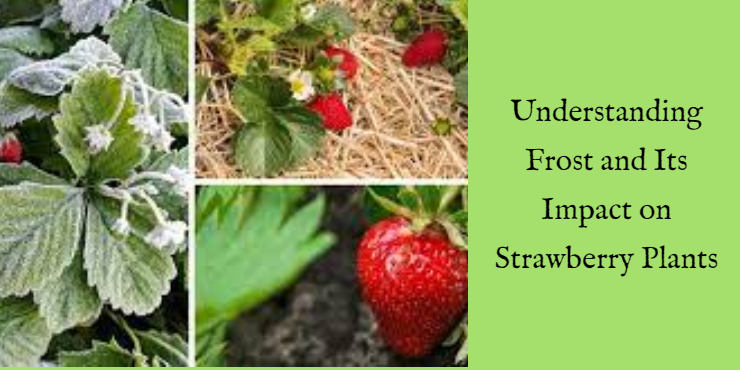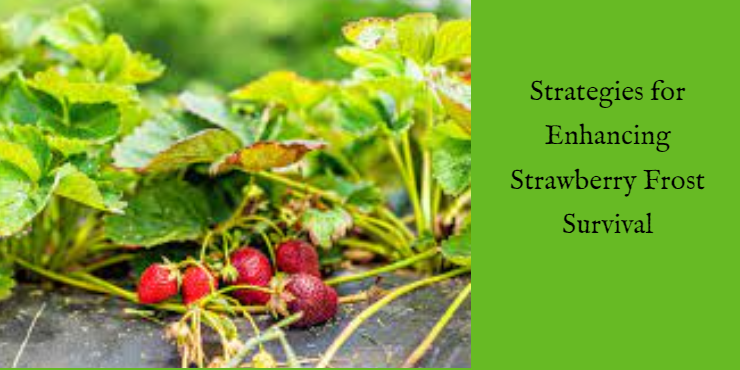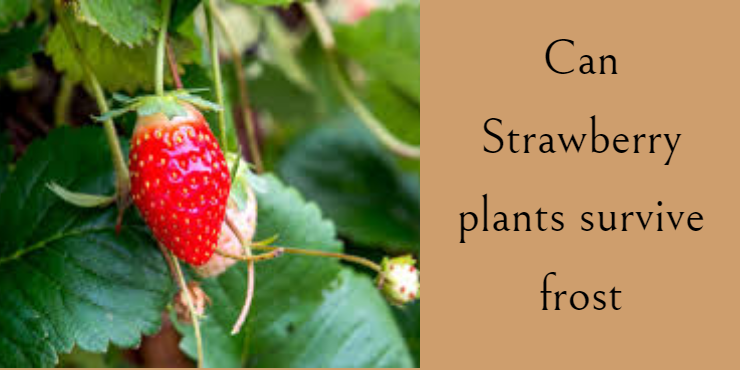Introduction: can strawberry plants survive frost
Strawberry plants, those delightful red jewels of the garden, are a favorite for many gardeners and fruit enthusiasts. Their sweet and succulent taste is the epitome of summer, but what happens when the cold, frosty embrace of winter threatens these fragile-looking plants?
In this article, we will explore the intriguing question: Can strawberry plants survive frost? Let’s delve into the world of strawberries and uncover the secrets of their resilience.
Understanding Frost and Its Impact on Plants

Understanding Frost and Its Impact on Strawberry Plants” explores the effects of frost on strawberry plants and provides insights for growers on how to mitigate its impact. This article explains that while strawberries are generally hardy plants, they are vulnerable to frost due to their shallow root systems and sensitivity to cold temperatures.
Before we dive into the specifics of strawberry plants, it’s essential to understand what frost is and how it affects various plants. Frost occurs when temperatures drop below freezing (32°F or 0°C), causing the formation of ice crystals on the surface of plants. These ice crystals can damage plant cells, leading to a range of issues, from wilting and browning to, in severe cases, plant death. By understanding the impact of frost on strawberry plants and implementing proactive measures, growers can ensure the longevity and productivity of their strawberry crops.
The Frost Threshold for Strawberries
The Frost Threshold for Strawberries” explores the delicate balance between temperature and the growth of strawberries, specifically in relation to frost. This article delves into the optimal temperature range in which strawberries thrive and the detrimental effects of frost on their development.
Strawberry plants belong to the Fragaria genus and are known for their vulnerability to frost due to their shallow root system and low-growing nature. However, strawberries can endure light frost to some extent.
Light Frost Tolerance
Light Frost Tolerance” refers to the ability of a plant or crop to withstand or tolerate light frost conditions without suffering significant damage or loss of health. Light frost typically occurs when the temperature drops just below freezing (32°F or 0°C) for a short period of time, causing ice crystals to form on the plant’s surface.
Plants with light frost tolerance have developed adaptations that enable them to endure these icy conditions without suffering extensive harm. When temperatures hover just below freezing for a short period, strawberry plants can often withstand it with minimal damage. They might experience some leaf damage, but the plants usually bounce back once temperatures rise.
Protecting Strawberry Plants from Frost
“Protecting Strawberry Plants from Frost” provides essential guidance on how to safeguard strawberry plants from the damaging effects of frost. This article highlights the vulnerability of strawberry plants to frost and explains the potential consequences of exposure, including stunted growth, reduced fruit production, and even plant death.
To protect your strawberry plants from light frost, consider using mulch or row covers. These measures can help insulate the strawberry plants and prevent frost from settling on their leaves.
Hard Frost and Strawberry Survival
Hard Frost and Strawberry Survival” delves into the impact of hard frost on strawberry plants and offers strategies to ensure their survival in extreme cold conditions. This article explains how hard frost, which occurs when temperatures drop significantly below freezing, can severely damage or even kill strawberry plants.
It explores the effects of ice formation on plant tissues, including cellular damage and dehydration. While strawberries can handle light frost, they struggle when faced with a hard frost, characterized by more extended periods of freezing temperatures. Hard frost can lead to more severe damage to strawberry plants.
Hard Frost Damage
Hard Frost Damage” explores the detrimental effects of hard frost on plants and crops. Hard frost occurs when temperatures drop significantly below freezing, causing ice crystals to form on plant tissues. This article discusses the potential damage inflicted by hard frost, including wilting, browning, and death of plant cells and tissues.
During a hard frost, strawberry leaves and blossoms can suffer significant damage, potentially impacting fruit production. In some cases, the plants may even die back to the ground. By following the insights provided in this article, gardeners, farmers, and plant enthusiasts can mitigate the potential harm caused by hard frost and ensure the health and survival of their beloved strawberry plants and crops.
Strategies for Enhancing Strawberry Frost Survival

Strategies for Enhancing Strawberry Frost Survival” delves into effective methods and techniques to boost the survival of strawberries during periods of frost. The article explains the particular vulnerability of strawberries to frost due to their shallow root system and susceptibility to dehydration. It highlights the importance of preventing desiccation during frost events to maintain plant health and vigor.
Now that we’ve discussed the challenges strawberry plants face when frost strikes, let’s explore some strategies to boost their chances of survival. By implementing the strategies outlined in this article, strawberry growers can increase the resilience of their crops to frost, minimize damage, and ensure more abundant and successful harvests
1. Select Frost-Resistant Varieties
Select Frost-Resistant Varieties” focuses on the importance of choosing and cultivating strawberry varieties that are resistant to frost. This article explains that frost-resistant varieties have genetic traits that allow them to tolerate or withstand cold temperatures more effectively than other varieties.
Choosing strawberry varieties known for their frost resistance is a smart starting point. Varieties like ‘Ozark Beauty’ and ‘Fort Laramie’ are known to withstand cold temperatures better than others. By selecting and cultivating frost-resistant strawberry varieties, growers can significantly reduce the risk of crop loss due to frost and enjoy more consistent yields and harvests.
2. Planting Location Matters
Planting Location Matters” emphasizes the significance of selecting the right planting location for various types of plants. This article explores how the location of a plant affects its growth, health, and overall success. Where you plant your strawberries can make a difference.
Select a site with good air drainage to prevent cold air from settling around the plants. Elevated locations can be helpful in this regard. By selecting an appropriate planting location, individuals can optimize the growth and development of their plants, enhance their resistance to pests and diseases, and ultimately improve the overall success of their strawberry garden or landscape.
3. Mulch for Insulation
Mulch for Insulation” explores the benefits and uses of mulch as an effective method for insulation in various gardening and landscaping applications. This article explains how mulch, which consists of organic or inorganic materials, can help regulate soil temperature, conserve moisture, suppress weed growth, and protect plants from extreme temperatures.
As mentioned earlier, mulching can provide a protective layer against frost. Apply a layer of straw or pine needles around your strawberry plants before winter sets in. By utilizing mulch for insulation, strawberry gardeners and landscapers can create a more favorable and supportive environment for their plants while minimizing the impact of extreme temperatures.
4. Row Covers
Row Covers” refers to a protective fabric or material that is used to cover rows of plants in order to shield them from various environmental factors and promote healthy growth. This article explores the benefits and uses of row covers in gardening and agriculture. Consider using row covers or frost blankets to shield your strawberry plants on particularly cold nights.
These covers trap heat and create a microclimate that can prevent frost damage. By using row covers, gardeners and farmers can protect their plants and crops from adverse conditions, extend the growing season, and improve overall plant health and productivity. Row covers are a versatile and effective tool in strawberry plant cultivation, allowing growers to create a controlled and protected environment for
5. Proper Pruning
Proper Pruning” refers to the technique of selectively cutting or removing specific parts of a plant, such as branches, shoots, or buds, to improve its overall health, shape, and productivity. This article explores the importance and benefits of proper pruning in gardening and horticulture.
Pruning your strawberry plants correctly in late fall can help them conserve energy and reduce vulnerability to frost damage. By practicing proper pruning techniques, gardeners can ensure the long-term health, productivity, and aesthetics of their plants. It is essential to familiarize oneself with the specific needs and characteristics of each plant species before engaging in pruning activities, and to always follow best practices to avoid damaging the plant.
Conclusion: The Resilience of Strawberries
In conclusion, strawberry plants can survive frost, but their resilience depends on various factors, including the severity of the frost and the measures you take to protect them.
By choosing the right varieties, planting strategically, and employing protective measures like mulching and row covers, you can help your strawberry plants weather the frosty challenges of winter.
FAQs (Frequently Asked Questions)
- Can strawberry plants survive a mild frost?
- Yes, strawberry plants can often survive mild frost with minimal damage.
- What are some frost-resistant strawberry varieties?
- Varieties like ‘Ozark Beauty’ and ‘Fort Laramie’ are known for their frost resistance.
- Do I need to cover my strawberry plants during frost?
- It’s advisable to cover strawberry plants with row covers or mulch during frost to protect them.
- When should I prune my strawberry plants for winter?
- Prune your strawberry plants in late fall to prepare them for winter.
- Can strawberries recover from severe frost damage?
- While strawberries can recover from some frost damage, severe damage may affect fruit production.
So, as you prepare your strawberry garden for the winter months, remember that with the right care and precautions, these resilient plants can continue to bring you sweet, juicy berries even in the coldest of seasons.
